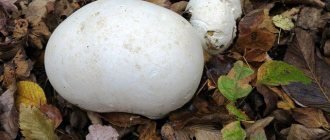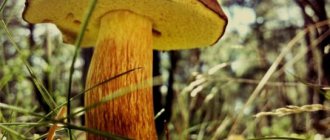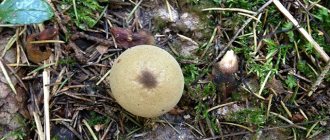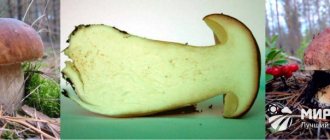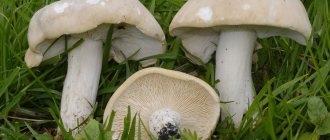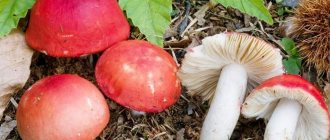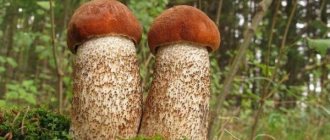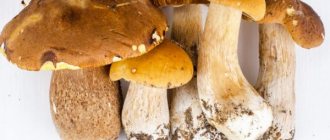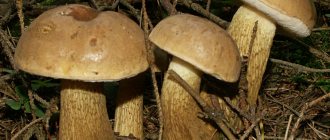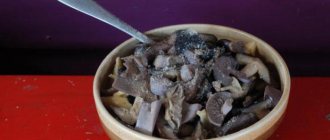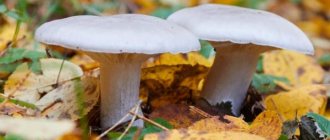Mushrooms
0
2072
Article rating
Kira Stoletova
The answer to the question whether false oyster mushrooms are poisonous is yes. But they only grow in Australia. In our latitudes there are inedible or conditionally edible varieties. It is not difficult to distinguish such mushrooms.
The main differences between false oyster mushrooms
Oyster mushroom orange
Orange oyster mushroom, according to the species description, grows in large families mainly in deciduous forests. Found on linden, aspen, birch, prefers rotten stumps and dead wood. Does well in temperate climates. Fruiting begins in September and continues until November. In warm areas, the mushroom can grow even in winter. Rarely seen. It stands out strongly against the green background of foliage, thanks to the bright orange color of the cap. If forest oyster mushrooms survive the winter, the color becomes paler.
The main differences include:
- almost complete absence of a stem: mushrooms are attached to the wood with a cap;
- cap 2-8 cm in diameter, fan-shaped;
- the skin is fluffy and tough;
- unusual smell: young specimens have the aroma of melon, mature specimens smell of rotten cabbage;
- hymenophore: lamellar, its color is brighter (darker) than the color of the cap;
- the pulp is bitter, pale orange;
- spores elongated, smooth;
- spore powder is light pink or brownish pink.
Irina Selyutina (Biologist):
You can sometimes find orange oyster mushrooms on sick or drying trees. Old reference books wrote very evasively that this mushroom is “conditionally edible.” Many modern definitions indicate that this is a mushroom from the “inedible” (but not poisonous) category. Some mushroom pickers collect them, but only young fruiting bodies with a melon aroma, but they avoid old ones because of their quality and very unpleasant smell - some describe it as rotten cabbage, others - like rotting carrots.
If desired, orange oyster mushroom mycelium can be found in the product catalog of some online seed stores, because it is advertised as a garden decoration, although inedible.
Orange oyster mushroom is used for landscape design. It is used to decorate gardens and courtyards, infecting trunks and tree stumps with mycelium.
False oyster mushrooms and look-alikes
Oyster mushrooms develop on wood - trunks, stumps, wood debris, have characteristic external features and it is almost impossible to confuse them with poisonous mushrooms. And yet, there are similar inedible species, of which the most common are Schizophyllum vulgaris, Pannelus astringentus, as well as various representatives of the sawfoil genus.
Sawfoil (Lentinellus ursinus)
Sawfoil (Lentinellus ursinus)
Small, light-colored mushrooms with an unpleasant bitter taste. The cap is round, up to 10 cm in diameter, convex, later spread out with a depression in the center, the edges are curled. The skin is of different tones of brown, most often light brown or beige, with a reddish, pinkish or yellowish tint. The plates are frequent, slightly descending onto a low, thin stalk, which can be located in the center or on the side. The pulp is creamy, thin, hard-fibrous, usually odorless, with a very bitter, pungent taste.
Representatives of the genus live in small groups on dead wood and stumps of poplar, birch, elm, and other deciduous trees, and less often on coniferous trees. Not used as food due to its pungent taste.
Common schizophyllum (Schizophyllum commune)
Common schizophyllum (Schizophyllum commune)
Tasteless mushrooms settle on wood, like oyster mushrooms, and in the same time frame. The cap is small - up to 5 cm in diameter, with an uneven wavy edge in the shape of a fan or shell. The skin is grayish, in wet weather it turns grayish-brown. A distinctive feature is the purple or reddish tint of rare plates. The leg is short or absent, located laterally.
The pulp is thin, tight, dryish fibrous-hard structure, without bitterness and odor. The species is not poisonous, but is of no value due to its low taste.
Panellus stipticus
Panellus stipticus
This mushroom is similar to the previous one, but has an unpleasant pungent taste. The cap is up to 4 cm in diameter, fan-shaped or shell-shaped, with an uneven rough surface. The skin is brown or brown, with an ocher tint. The plates are frequent, the same color as the cap, the stem is brown and short. The pulp is yellowish-brown, hard, fibrous, bitter with a tart, astringent aftertaste.
A common species, often found in large colonies in rainy spring or autumn on any deciduous trees, most often oak stumps and dead wood. Dried dead fruiting bodies of Pannelus astringentum can be seen on dry wood. It is unsuitable for food due to the hard structure of the pulp and disgusting taste.
Wolf's saw-leaf
Wolfsaw leaf is also not classified as a poisonous counterpart to edible oyster mushrooms. Its second name is bald sawfoil. It grows on dead wood of trunks and stumps. Rarely found in deciduous and coniferous forests. Grows in central Russia, North America, Canada, and Europe (except for the southern regions). Fruits from July to October.
To distinguish a mushroom, you should carefully study its description:
- the cap is kidney- or tongue-shaped, 3-8 cm in diameter, skin color – whitish-brown, yellow-red;
- the leg is dense, colored brown, almost black, not centered, 1 cm long, rudimentary (lost its significance in the process of evolution);
- the surface of the cap is felt, with small scales and growths;
- hymenophore: represented by plates, at first they are white-yellow, then turn red, running down the stalk, frequent, wide;
- uneven, jagged edge on the back of the cap (the main difference), folded down;
- the pulp is whitish, hard, acrid;
- the aroma is pronounced, mushroom;
- white spore powder.
The caps sometimes grow together to form groups. Wolfsaw leaf is not used in cooking because of its pungent taste, which does not disappear even after prolonged heat treatment.
What mushrooms are similar to oyster mushrooms?
Let's return to our topic. It is quite simple to distinguish forest orderlies from “good” mushrooms. Next, we will present to your attention a description of the most common wood destroyers, some of which are not recommended.
Wolf (bald) sawfolium
The culture is found in regions famous for their cool-temperate climate. As a rule, this is central Russia, where lowland, mixed forests with meadows predominate. The ideal substrate for the plant is dead, coniferous or deciduous wood. The growing season is late June – mid-October.
In the photo - Tiger sawfolium.
Main distinctive features:
- A red-yellow or brown cap, visually reminiscent of a tongue or kidney. The optimal diameter is about 4-9 centimeters. The skin is velvety, matte, strewn with small irregularities and scales. The edges are jagged, irregular, and rounded at the bottom.
- On the back of the “head” there are thin light plates that become red with age. The spores are white and small.
- The stem is burgundy-brown, very dark, and consists of hard fibers. Almost invisible from under the cap, as it plays the role of “adhesion” to the host plant.
- The pulp is beige, bitter, tough, and exudes a deceptive mushroom aroma.
Often the hats of sawfoil grow together, forming an incomprehensible plant “construction”. The mushroom is not suitable for culinary use.
False orange variety
The orange inedible oyster mushroom prefers to grow on deciduous trees, mainly on birch, alder, aspen, hazel, and linden. The ideal climate for the crop is moderate. The period of ripening of fruiting bodies is the autumn months (for cold regions). If we are talking about southern cities, fruiting can continue all winter. Doesn't happen often.
The mushroom is easy to recognize due to the bright orange color of the cap; over time, the color becomes duller, especially if the false gris grew in the spring, but continues to live throughout the winter.
Main distinctive features:
- “Hat” fastening to wood, that is, the absence of a leg.
- A small head, shaped like a fan.
- The top layer is velvet, the back side of the cap is strewn with plates, their color is even brighter than the “front” part.
- The pulp is pastel orange, bitter, and when the young mushroom is broken, it emits a pleasant melon aroma. If the specimen is overripe, its smell resembles the stench of spoiled vegetables and is sour.
- The spores are pink.
Mushrooms are not eaten, but are popular among landscape designers and gardeners who nurture their territory.
Green oyster mushroom
Mushrooms need to be cooked properly
Green oyster mushroom is often classified as a false species. If not boiled correctly, it will not be edible. Mushroom of low quality, conditionally edible. Its second name is late (autumn) oyster mushroom. The species is distinguished by late fruiting: from September until the first frost. Autumn oyster mushrooms resume their growth during thaws. They are found in February and March.
These mushrooms are found in mixed and deciduous forests of the European part of Russia, Ukraine, the Caucasus, and Northern Asia. They are found individually or in families. They grow on wood, stumps and dead wood.
How oyster mushrooms grow in nature
There are about 30 types of mushrooms, although only about 10 of them are grown in home gardens. However, these mushrooms are quite popular due to their high taste, rich aroma and low maintenance requirements.
Under natural conditions, they grow on tree trunks, mostly deciduous, but some species can also be found on conifers. The most unpretentious is the steppe, which can grow on trees of any species, and even on old fallen trunks or stumps.
Description
Oyster mushrooms are most often used in cooking. This type of mushroom has a fairly large fruiting body. The size of the cap ranges from 4 to 12 cm. The shape is round. The surface is smooth and glossy. The age of the fruiting body can be determined by the color of the cap: in young mushrooms it is gray, in mature ones it has a purple tint, and in old ones the color changes to white or yellow.
The stem of oyster mushrooms is short (2–7 cm) and thin (up to 2.5 cm). It is located on the edge of the cap. Its color is no different from the top of the mushroom. The pulp has a very pleasant smell. It is thin and dense. White color. The plates are light yellow. They are attached and go down the leg.
Varieties of forest mushrooms, their descriptions and photos
There are many varieties of oyster mushrooms in the forest, and it is advisable to familiarize yourself with photos and descriptions of them before a quiet hunt.
Pulmonary
This species is very common in forests throughout the country. The round or fan-shaped cap reaches a diameter of 4-8 cm. The color is white or cream, and mature individuals acquire a yellowish tint. The short leg at the base is covered with barely noticeable pile, and its length does not exceed 20 mm.
Lemon (elm)
Lemon oyster mushroom can most often be found in the Far East. This species also grows well at home. The average diameter of the cap is 3-6 cm. Young mushrooms form a corymbose cap, which becomes funnel-shaped with age. The lemon-yellow color of the skin fades as it grows.
Royal, or steppe
Mature fruits have a flat or slightly funnel-shaped cap, on which small fibers or scales can be seen. The diameter of the cap can reach 13 cm. The surface is painted in red-brown tones, which fade to brown over time. Most often, the compact leg is located in the center. The cylindrical leg can be white or light ocher in color.
Royal oyster mushroom
Ordinary or oyster
The diameter of these forest inhabitants ranges from 5 to 15 cm. The color of the surface is quite variable and can be brownish, ashen or light gray with a purple tint. At first, the edges are tucked inward, and with age they acquire a wavy or dissected-lobed shape. If the fruits live in places of high humidity, then a mycelial coating appears on their surface.
Oyster mushroom
Late or autumn
The diameter of the cap can reach 12 cm. A distinctive feature of the species is the ear-shaped cap of a brown-gray color. The surface of the mushroom is velvety. A group of fruits grows from a single base. The white pulp is quite dense and is characterized by a pleasant smell and taste.
You may be interested in:Edible mushrooms similar to toadstools, their description and appearance (26 photos) One of the most poisonous representatives of forest flora is a mushroom called toadstool. It’s interesting that...Read more...
Covered or single
This representative of the mushroom world lives on rotting birch, aspen, oak, and spruce trees. The mushroom cap is initially creamy-gray in color, but with age it becomes gray-brown in color. Its average diameter is 8 cm. The shape of the cap is tongue-shaped or ear-shaped. The surface is covered with scales. The leg is very compact or absent altogether.
Oyster mushroom covered
Horn-shaped, or abundant
The shape of the fruiting body resembles a shepherd's horn. The cap is horn-shaped, sometimes leaf-shaped. Ripe fruits are characterized by smooth edges, which are often curved upward and covered with cracks. Unlike other varieties, this mushroom has a well-defined curved stalk, the length of which is up to 8 cm. Depending on living conditions, the surface color ranges from sand to gray.
Oyster mushroom
Pink
The pink or flamingo oyster mushroom has a slightly convex cap up to 5 cm in diameter. The pink flesh has an oily taste and an original aroma. A pale pink stalk grows from the side of the cap and is often curved. The plates are red-pink in color.
Pink oyster mushroom
When and where do oyster mushrooms grow?
Oyster mushrooms settle in groups on deciduous trees: birch, oak, aspen, etc. They can also be seen on fallen branches, trunks and stumps. Less common on coniferous trees. Often these mushrooms are grown at home in a special substrate, which consists of plant waste.
They bear fruit intensively from May to September, but oyster mushrooms can be collected in the wild until November. In winter, the growth of mushrooms stops, after which their condition largely depends on the time of frost and the stage of development at that moment. If the fruiting bodies managed to ripen before the onset of low temperatures, then in winter they can continue to hang in the place where they grew.
In this state, the mushrooms are semi-solid and can be cut off. If the frost was preceded by rainy weather, then it will not be possible to cut the oyster mushrooms from the tree, since they will be very hard. To get a group of fruiting bodies, they must be knocked down.
Growing oyster mushrooms manually “on the ground”
During the cold season, trunks are cut, possibly from poplar, with a diameter of more than 20 cm. The winter period is important because the tree must stop growing. Once trimmed, the stumps are stored upright in a shady area to await use, which usually occurs between April and June.
30 cm segments are cut from the trunks, holes are dug 1 meter wide and 120 cm deep. A layer of mushroom mycelium is placed at the bottom of the pit, and vertically located trunks are placed on top. Then another layer of mycelium and a trunk, and so on. The upper part is covered with boards and a 15 cm layer of soil is poured.
The heat and humidity that forms inside the pit will facilitate the distribution of mycelium over the logs laid inside. In September, the trunks are removed and buried one by 15 cm, at a distance of 30 cm from each other. In about twenty days, oyster mushrooms will begin to grow, which is repeated in each subsequent season.
The most common oyster mushrooms
The most common types of oyster mushrooms include:
- Pulmonary. The diameter of the cap reaches 15 cm. The color is light gray in the young fruit body and yellowish in the old one. Fan shape. The stem is short and matches the color of the cap. The mushrooms are meaty and have a pleasant aroma. This species is edible and very tasty. They usually grow on deciduous trees in forests or park areas. They bear fruit from July to September.
- Royal. This is a delicious type of these mushrooms, hence the name. The cap is small in size - 4–13 cm. Young mushrooms are white with a red or gray tint, and old ones become yellow. The leg is small - up to 4 cm. The plates are not densely located. The pulp is dense and fleshy. The taste is light with pleasant mushroom notes. Such oyster mushrooms grow in the steppe zone, which distinguishes them from all other species. They bear fruit in the first half of autumn.
- Autumn . The hat (length about 12 cm, width - 6 cm) looks like the shape of an ear. The color is gray and darkens as the mushroom grows. The pulp is white and aromatic. The plates are also white. The leg is short, dense and slightly drooping. You can see such mushrooms on stumps and deciduous trees. They usually live in mixed forests. They bear fruit from August to December. Edible mushrooms.
- Horn-shaped . The mature cap of the fruiting body has a horn-shaped shape measuring 4–13 cm. The color is white or yellow, but as it ripens it becomes brown. The leg is very short, about 1 cm long. It comes in a milky or gray shade. The plates are light and sparsely located. The pulp is fleshy, aromatic and tight. They prefer to grow on aspens, birches, oaks, rowan trees or maples. They bear fruit from May to September.
- Oak. The cap has a convex semicircular or oval shape with wavy edges, up to 10 cm in size. In a mature mushroom, it becomes concave. The color is cream or yellow. The leg is short and cylindrical. The plates are densely located. Their color matches the color of the cap. The pulp has a light sweetish aroma, but is hard and dense. This type of oyster mushroom grows on deciduous trees in temperate climates. Fruits in the second half of summer and early autumn.
What trees do oyster mushrooms grow on?
The name of the mushrooms says a lot - just see how they grow.
Oyster mushrooms are located on trees and stumps as if hanging in the air. In nature, they are absolutely unpretentious, little dependent on high temperatures, prefer coolness, and begin active growth from September to December. About 30 varieties of this mushroom are known, and only 10 of them are grown under artificial conditions.
You may be interested in:
Description and photos of edible mushrooms Mushroom pickers are not born, but become. You can master the complex science of edible and poisonous mushrooms at any age,...Read more...
Ordinary or oyster
Common oyster mushroom (Pleurotus ostreatus) - found in broad-leaved forests, prefers stumps and dead wood of deciduous trees (birch, oak, elm, rowan). It has a semicircular cap, resembling an ear, up to 20 cm in size, grayish-yellow in color.
The pulp is white and has a pleasant smell. This variety is harvested from June until the first frost. The young mushroom is edible, and can often be found on the table in fried, boiled, or pickled form.
Horn-shaped, or abundant
Another variety is the horn-shaped, or abundant, oyster mushroom. As you can see from the photo, its cap is cream-colored, has a concave shape with wavy edges, the size varies - from 3 to 12 cm. It grows preferably in deciduous forests (birch, oak, elm, rowan).
It is better to collect in the summer, as it does not tolerate low temperatures well, which is why it will be quite difficult to find it in cold weather. It lives on the trunks of rowan trees, oaks, birches, and maples. It is used as a filling for pies and other flour products, as well as fried and pickled.
Pulmonary
Pulmonary oyster mushroom has its own peculiarity, different from others - it has a very delicate appearance. The body is white, the cap is convex, lowered down. Because of such a sophisticated appearance, mushroom pickers often worry that the mushrooms will be damaged during transportation, but this is not the case.
Despite their delicacy, they are quite strong and durable. It grows mainly in families, on the trunks of old birch, beech, and oak trees. Relatively indifferent to cold weather, it is harvested until the first frost.
Lemon (elm)
The lemon, or elm, variety is especially common in Asia, North America and the Far East. Although it can be grown quite successfully at home. This species acquired a rather atypical name for a mushroom due to its color. The color of the stem and fruiting body is bright yellow. Its taste qualities are highly valued; dishes with its addition acquire a delicate nutty hue and a bright aroma.
Another name - elm, or ilmak mushroom, characterizes the place of growth, and not external signs. The most typical place where the fungus is found in nature is elm, a special variety of elm that grows in the Far East.
This is one of the most sought after species, but due to its fragility, these mushrooms are difficult to transport. If you are growing lemon oyster mushrooms at home, then sawdust, poplar, beech, birch or oak wood are best suited for this.
You may be interested in:
How to recognize a mushroom with a cap and a white stalk: names and types (32 photos) Mushrooms are a wonderful culinary product, successfully used for preparing various dishes. The most…Read more…
Pink
Under natural conditions it is found in countries with a tropical climate or in the Far East, on the trunks of deciduous trees. It grows mainly in families, so if mushroom pickers are lucky enough to come across a group of pink oyster mushrooms in the forest, it is difficult to go home without a full basket.
It is easily cultivated at home; straw or corn waste is usually used for this. It is believed that the pink variety does not have any special taste or nutritional properties.
Late or autumn
Autumn oyster mushroom (Pleurotus salignus) grows on the trunks and stumps of deciduous trees. The shape of the hat resembles an ear, elongated to one side, gray or gray-brown in color, reaches 12 cm. As for the stem, it is not smooth, but has a light fluff on its surface.
The pulp is white and has a pleasant aroma. Autumn oyster mushrooms are harvested mainly in September and October and served fried, boiled and pickled.
Are there poisonous oyster mushrooms, what mushrooms can be confused with, how to distinguish
In Russia there is no poisonous analogue of oyster mushrooms. Dangerous mushrooms of this species can only be seen in Australia. But you shouldn’t relax because of this.
False species are often found on the territory of our country, such as:
- Orange oyster mushroom . The fruit body of this species is very hard, so it is not popular among fans of this food product. Orange mushrooms look very beautiful and are often planted to decorate the garden. It will not be possible to confuse these oyster mushrooms with ordinary ones, since the main and noticeable difference is the color of the mushrooms.
- Wolf's saw-leaf. The fruit bodies are very bitter and therefore inedible. Color yellow-red. The legs are often fused. Ripe mushrooms have an unpleasant aroma similar to the smell of rotten cabbage.
- Green . The color of oyster mushrooms corresponds to the name of this species. The taste is bitter.
Taste qualities and uses in cooking
This product can safely be called dietary. It is included in the diet of almost all the most popular and effective diets. Oyster mushrooms are low in calories (only 40 kcal), but very nutritious. The taste of these mushrooms can complement any salad or dish. Oyster mushrooms are often preferred as an additional ingredient in cooking. It is also worth noting the good aroma of the fruiting body. It is preserved not only fresh, but also cooked.
There are many options for using oyster mushrooms in cooking. They can be:
- stew;
- bake;
- cook;
- fry;
- grill;
- pickle, etc.
Before you start preparing the product, you need to pay attention to the color of the oyster mushrooms. It must be uniform - this is a sign of quality. Fruit bodies must be free of rot and damage. It is also important to use young mushrooms in cooking. They have better taste than the old ones.
How to cook autumn oyster mushroom?
You can cook a variety of dishes from autumn oyster mushrooms: boil, pickle, fry. Mushrooms can also be dried and then used to make soups, stuffings, salads, casseroles, etc.
Oyster mushroom fried in sour cream
The easiest way to cook oyster mushrooms is to fry them with onions. But you can make a more sophisticated dish if you add sour cream to it.
Ingredients:
- boiled mushrooms - 0.5 kg;
- sour cream - 75 ml;
- onion - 75 g;
- garlic - 1-2 cloves;
- oil/lard - for frying;
- salt and pepper to taste.
How to cook:
- Rinse and clean the ingredients. Cut the onion into rings, chop the garlic finely or crush it in a garlic press.
- Heat a frying pan and add oil, then oyster mushrooms. Fry the mushrooms until all the liquid has evaporated.
- Salt and pepper the mushrooms, pour in the sour cream and add the garlic. Cover the mushrooms with a lid and simmer them over low heat for about half an hour.
- Turn off the stove and let the dish stand for 10-20 minutes. If desired, sprinkle the mushrooms with chopped herbs.
Fried oyster mushrooms in sour cream can be served as a separate dish or along with a side dish - buckwheat porridge, potatoes, rice, pasta.
Oyster mushroom fried in batter
This recipe is suitable for both an everyday table and a festive feast. The dish is easy to prepare and the whole process does not take much time.
Ingredients:
- mushroom caps - 1.2 kg;
- flour - 75 g;
- eggs - 3 pcs.;
- vegetable oil/ghee;
- salt and seasonings to taste.
How to cook:
- Salt the caps and sprinkle with spices.
- Prepare the batter by mixing eggs with flour and salt. Stir until smooth.
- Heat the frying pan. Pour oil or fat into it. So much so that the bottom of the dish is covered by 5-8 mm. Otherwise, the mushrooms will not cook well.
- Dip each cap in the batter and fry on both sides until golden brown.
Place the finished oyster mushrooms on a napkin to drain excess oil. Serve the mushrooms in batter along with sour cream, sauce, and herbs.
Autumn oyster mushroom is an accessible and widespread mushroom, which is unique in that it grows in the cold, non-mushroom season. Thanks to this late mushroom, you can enjoy fried mushrooms until December.
0
0
Copy link
Benefits and possible harm
Oyster mushrooms are very useful. They contain substances (proteins, carbohydrates, fats, mineral salts and vitamins) that have a beneficial effect on our body. The amount of fats and carbohydrates in the product exceeds that of vegetables, and the content of amino acids and proteins is almost the same.
The composition of vitamins (B, C, D and D) in mushroom pulp is similar to that of meat. But the greatest value of mushroom dishes is their high content of vitamin PP.
- Regular consumption of oyster mushrooms promotes:
- lowering cholesterol levels;
- suppression of the development of E. coli;
- breakdown of glycogen and fats;
- removal of radioactive elements;
- increasing the body's resistance to radiation;
- cancer prevention;
- cleansing the body of heavy metal salts;
- normalization of the digestive tract.
This type of mushroom is one of the most harmless. If you collect fruiting bodies in environmentally safe places and prepare them correctly, they will not harm you.
Is it possible to eat autumn oyster mushrooms?
Autumn oyster mushrooms are conditionally edible mushrooms, so they can be eaten only after heat treatment. They are not eaten raw. According to the mushroom classification, oyster mushrooms belong to the 4th category, which indicates its not particularly high taste characteristics.
In young specimens, the pulp has a delicate herbaceous aroma and a slightly bitter taste. In mature mushrooms, the skin becomes slimy and unpleasant to the touch. Their flesh is hard, and after frost it is also very bitter.
Overripe mushrooms can also be eaten. But you must remove the slippery skin from them, and then simmer for a long time to soften the hard flesh.
To make mushrooms tasty and safe, they are prepared immediately after picking:
- Sort through and clean from debris - leaves, pine needles, etc.
- Inspect each mushroom for damage, cut off any darkened, dry areas.
- Pour water over the peeled mushrooms, add a pinch of salt and simmer over low heat for 20 minutes.
- Drain the mushroom broth - it should not be eaten as food, it contains substances that can harm the body.
- Rinse boiled mushrooms with running water.
Only after such processing can oyster mushrooms be used for preparing other dishes and eaten.
After the temperature drops below 0 °C, mushrooms lose some of their taste properties, but they can still be eaten. If frost follows frost, you should not pick mushrooms - although they look good, they turn sour inside.
Interesting Facts
Fungi that live on trees are wood destroyers. This is due to the fact that their mycelium is located in the middle of the wood, which entails the destruction of its composition.
On dead trees, oyster mushrooms perform a very useful function. It turns out that they clear the forest of dry trunks and branches, turning them into dust, which over time forms fertile soil. These are natural orderlies, without whom the entire earth would be covered with the remains of old wood. By clearing the forest, they enable young trees to grow.
Oyster mushrooms have long gained popularity among lovers of tasty mushrooms. If you prepare them correctly, they become a real delicacy, and the beneficial properties of this product will replenish your body with essential vitamins and substances.
Possible harm
When consuming oyster mushrooms, you should remember about the conditional edibility and other features of this mushroom that can cause harm to the body.
Limitations and possible harm:
- the pulp contains chitin, which is almost not absorbed by the child’s body, so oyster mushrooms should not be given to children under 5 years old;
- Children over 5 years old can be given mushrooms, but in small quantities;
- It is not recommended to eat oyster mushrooms for people who have problems with the liver, gastrointestinal tract, pancreas, and kidneys;
- People prone to allergies should collect and process oyster mushrooms with caution - mushroom spores, once in the body, can provoke an allergic reaction;
- Oyster mushrooms will not cause harm if you eat them no more than 2 times a week.
There is an opinion that oyster mushrooms are harmful to health. European scientists say that these mushrooms contain toxic substances that can accumulate in the body.
How to distinguish false forest oyster mushrooms from edible ones
Many lovers of “silent hunting” agree that oyster mushrooms growing in the forest are more aromatic and tasty than their “brothers” grown at home. In the forest, oyster mushrooms grow on fallen, dying or diseased tree trunks, rotten or rotten stumps. However, when going into the forest to “grind”, you need to know not only where these fruiting bodies grow, but also how to distinguish edible oyster mushrooms from false ones. Otherwise, due to inexperience, you can collect inedible mushrooms and harm your health.
Description of edible oyster mushrooms
Before you understand how to distinguish false oyster mushrooms from their edible “colleagues,” you should remember one important detail. The fact is that there are no poisonous representatives of this species on our territory, unless, of course, you collect them in Chernobyl or near Fukushima. The poisonous counterpart of the oyster mushroom grows only in Australia.
And although false oyster mushrooms grow on the territory of Russia, Ukraine and Belarus, they are not poisonous. They are classified as conditionally edible or inedible mushrooms. But they are almost impossible to confuse with species that are freely eaten.
Today, the most common representative of edible oyster mushrooms is the common oyster mushroom or oyster mushroom. We suggest that you familiarize yourself with its description in more detail, because knowing the characteristics of this mushroom, you can easily distinguish it from false species.
Latin name: Pleurotus ostreatus.
Family: Oyster mushrooms.
Doubles: No. Similarities with the Australian poisonous mushroom Omphalotus nidiformis (Berk.) are mentioned.
Cap: Fleshy, round, resembling an oyster in appearance. The upper part is smooth and glossy, rarely wavy. It has a gray color, brown, purple, white and yellow shades are allowed. The size of the cap ranges from 3 to 25 cm in diameter.
Leg: Short, inconspicuous, widened at the cap side. Smooth, cream or white in color, closer to the base it becomes fleecy and hard.
Pulp: Light, dense, juicy and soft. In adulthood, the pulp becomes significantly tougher, and the appearance of tight fibers is observed.
Application: They are widely popular in cooking. They lend themselves perfectly to pickling, frying, stewing, canning, drying, freezing, pickling and pickling. In medicine, oyster mushrooms are used to make medicines used in the treatment of cancerous tumors, as well as during radiation and chemotherapy.
Edibility: Edible mushroom, belongs to category IV.
Distribution: Deciduous, less often coniferous forests. It grows in all territories of the former countries of the Soviet Union.
In addition, other forest edible oyster mushrooms can be found less frequently: carob-shaped, steppe, pulmonary and royal.
Characteristics of oyster mushrooms
All novice mushroom pickers need to know what the common types of oyster mushrooms growing in the forest look like in order to avoid unpleasant consequences.
Appearance, photo, description
These fruits can grow from 5 to 20 cm in diameter. The color of young fruits is dark gray or with a brownish tint. Older ones are dark gray with a purple or ashen tint.
The color of the cap depends on the specific species and growing conditions. The shape of the mushroom often resembles ears.
There are no clear boundaries between the cap and the stem. The cap of this variety smoothly merges into the stem and becomes slightly thinner towards the edges. Its shape is oval, slightly elongated and looks like a shell. The diameter varies between 5-17 cm. The edges are slightly turned inward. The surface can be gray, lemon yellow, off-white with a purple, orange or pink tint.
The leg is most often lateral and noticeably narrows towards the base. Its length does not exceed 50 mm and width – 30 mm. The tube foot is painted in light shades of grey, yellow or white.
You may be interested in:
Description of black chanterelles and where do these mushrooms grow (21 photos)? Chanterelles are one of the most famous and useful mushrooms, which have a rather unusual appearance.... Read more...
Young fruits are characterized by juicy and elastic pulp. In older mushrooms, it becomes fibrous, dry and harsh in taste. The pulp has a pleasant mushroom smell. The taste of the raw fruit is neutral and bland.
Depending on the species, the spore powder is pink, cream or white. The size of the spores ranges from 7.5 × 3 to 12 × 4.5 μm. The shape is uneven, ellipsoidal.
Place of distribution and collection rules
Oyster mushrooms live in Europe, Asia, Australia and North Africa. Varieties of this fruit are quite common in Germany, France, Portugal, Slovakia and Poland. In Russia, the mushroom is considered one of the most common and can grow throughout the country, from the border with Belarus to the Primorsky Territory. Western Siberia is especially rich in oyster mushrooms, in whose birch and aspen groves you can harvest a considerable harvest.
Popular articles Description of juniper Variegata, planting and care
It is better for beginners to go mushroom picking in the company of an experienced mushroom picker, because there is a chance of confusing oyster mushrooms with their inedible counterparts. Before a quiet hunt, you should familiarize yourself with the varieties of this fruit.
Remember! Mushrooms should be looked for on the trunks of damaged deciduous trees, stumps and dead wood. Some species live on rotting wood or form mycorrhizae with the roots of umbrella plants. You can also find groups of fruits on some conifers.
You may be interested in:
Instructions for growing golden harvest mushrooms at home (21 photos) Forest mushrooms always pose a danger to the mushroom picker, so many people prefer to grow eco-mushrooms at home. Today it is not…Read more…
Edibility
Oyster mushroom is one of the edible representatives of the mushroom world. In Russia, this mushroom ranks second in popularity. It is used to prepare a wide variety of dishes. Oyster mushrooms can be fried, boiled, stewed, salted and pickled, and even eaten raw. The fillings made from them are delicious. You can often see buns, pies, pizzas and mushroom sauces made with these fruits.
